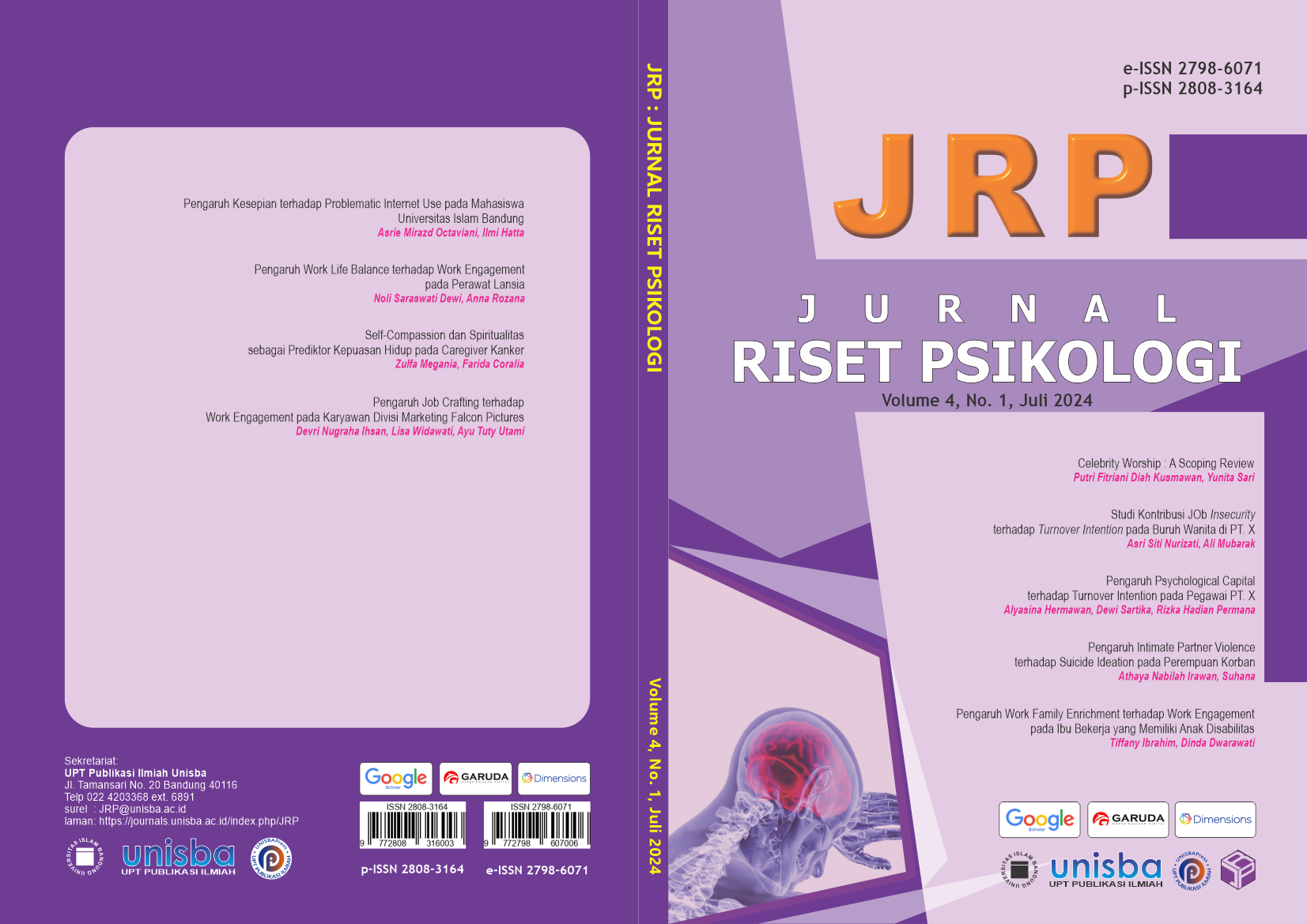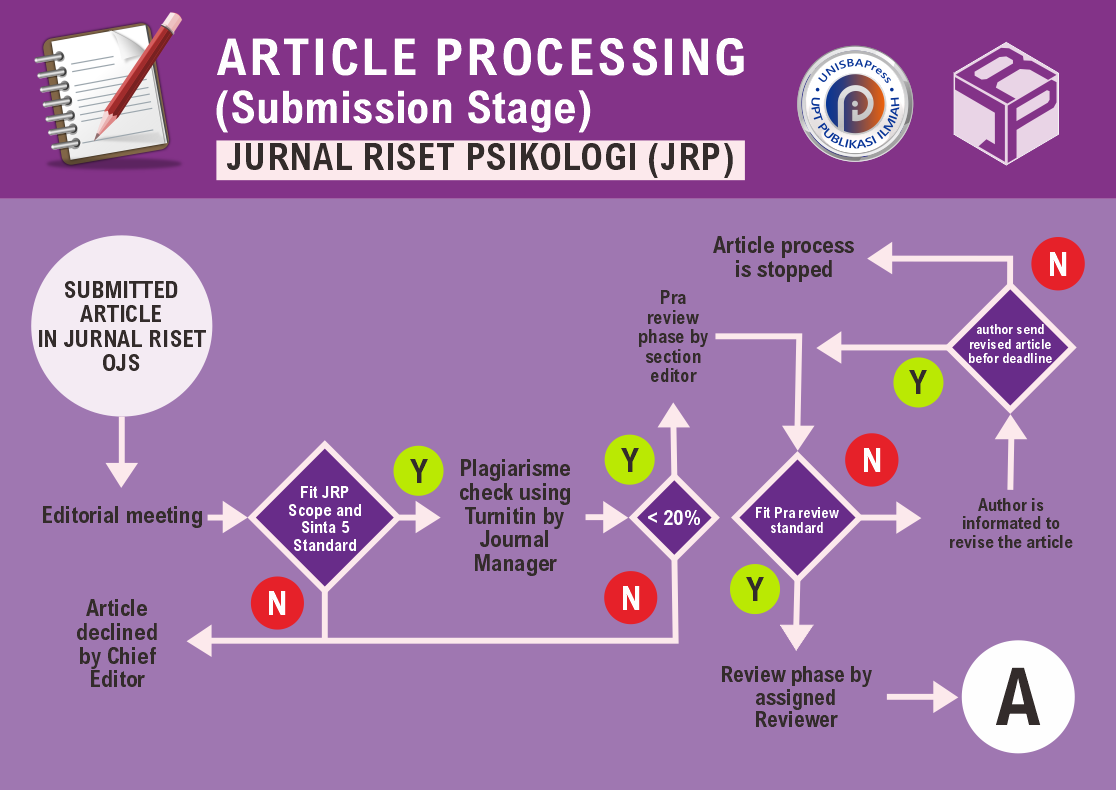Studi Kontribusi JOb Insecurity terhadap Turnover Intention pada Buruh Wanita di PT. X
DOI:
https://doi.org/10.29313/jrp.v4i1.3758Keywords:
Job Insecurity, Turnover Intention, Female WorkerAbstract
Abstract. Job insecurity is the perception, feeling of helplessness, and anxiety felt by employees facing the possibility of losing their job (De Witte, 1999). Roodt (2004) defines turnover intention as an employee's intention to leave the organization consciously and deliberately by the employee to leave the organization. This research aims to find out how job insecurity and turnover intention among female workers at PT. X. The hypothesis in this research is that job insecurity makes a significant contribution to turnover intention among female workers. The measuring instrument used is the job insecurity scale, developed by De Witte (2014) and adapted by the researchers themselves. The measuring instrument to measure turnover intention is scale developed by Bothma & Roodt (2013) which was also adapted by researchers themselves. The research results show that there are 51.9% of female workers who have high job insecurity, and 48.1% of female workers who have high turnover intention. Job insecurity contributed 67.9% to turnover intention in this study.
Abstrak. Job insecurity merupakan persepsi, perasaan tidak berdaya, dan kecemasan yang dirasakan karyawan menghadapi kemungkinan kehilangan pekerjaan. [1]. Roodt (2004) mendefinisikan turnover intention sebagai niat karyawan untuk meninggalkan organisasi secara sadar dan disengaja oleh karyawan untuk meninggalkan organisasi. Penelitian ini bertujuan untuk mengetahui bagaimana job insecurity dan turnover intention pada buruh wanita di PT. X. Hipotesis dalam penelitian ini adalah job insecurity memberikan kontribusi yang sigrnifikan terhadap turnover intention pada Buruh Wanita. Alat ukur yang digunakan adalah alat ukur job insecurity yang dikembangkan oleh De witte (2014) dan diadaptasi sendiri oleh peneliti, lalu alat ukur yang digunakan untuk mengukur turnover intention yaitu alat ukur yang dikembangkan oleh Bothma & Roodt (2013) yang juga diadaptasi sendiri. Hasil penelitian menunjukkan bahwa ada 51,9% Buruh wanita yang memiliki job insecurity yang tinggi, dan 48.1% buruh wanita yang memiliki turnover intention yang tinggi. job insecurity memberikan kontribusi sebesar 67,9% terhadap turnover intention dalam penelitian ini.
References
H. De Witte, “Job Insecurity and Psychological Well-being: Review of the Literature and Exploration of Some Unresolved Issues,” European Journal of Work and Organizational Psychology, vol. 8, no. 2, pp. 155–177, Jun. 1999, doi: 10.1080/135943299398302.
C. F. C. Bothma and G. Roodt, “The validation of the turnover intention scale,” SA Journal of Human Resource Management, vol. 11, no. 1, Apr. 2013, doi: 10.4102/sajhrm.v11i1.507.
N. Iswadi and D. H. Wibowo, “Hubungan Antara Konflik Peran Ganda Dengan Motivasi Kerja Pada Wanita Pekerja,” Journal of Psychology Humanlight, vol. 2, no. 2, pp. 26–40, 2021.
M. R. Sarina and M. R. S. Ahmad, “Diskriminasi Gender Terhadap Perempuan Pekerja Di Kawasan Industri Makassar,” Pinisi Journal of Sociology Education Review, vol. 1, no. 2, pp. 64–71, 2021.
Y. I. Lestari, “Fear of Success pada Perempuan Bekerja Ditinjau dari Konflik Peran Ganda dan Hardiness,” Jurnal Psikologi, vol. 13, no. 1, p. 55, Apr. 2018, doi: 10.24014/jp.v13i1.3090.
I. Abdurrahman and H. Nurtjahjanti, “HUBUNGAN ANTARA WORK-FAMILY CONFLICT DENGAN KETERLIBATAN KERJA PADA KARYAWAN WANITA,” Jurnal Empati, vol. 6, no. 3, pp. 330–336, 2018.
M. Rizal, “Pengaruh Uu Cipta Kerja (Omnibus Law) pada Kesejahteraan Pekerja Perempuan,” Jurnal Sekretaris & Administrasi Bisnis (JSAB), vol. 5, no. 2, p. 162, Aug. 2021, doi: 10.31104/jsab.v5i2.231.
N. I. Asmani and A. M. Fauzi, “Penolakan Omnibus Law Menurut Paradigma Sosiologi Hukum dan Teori Konflik,” Jurnal Justisia : Jurnal Ilmu Hukum, Perundang-undangan dan Pranata Sosial, vol. 6, no. 1, p. 102, Aug. 2021, doi: 10.22373/justisia.v6i1.10614.
R. Setiawan and B. Hadianto, “Job insecurity dalam organisasi,” Jurnal Manajemen Maranatha, vol. 7, no. 2, pp. 69–79, 2008.
T. R. Rizky and N. Sadida, “Hubungan antara Job Insecurity dan Employee Well Being pada Karyawan yang Bekerja di Perusahaan yang Menerapkan PHK di DKI Jakarta,” Jurnal EMPATI, vol. 8, no. 1, pp. 329–335, Jan. 2019, doi: 10.14710/empati.2019.23651.
N. Khadijah, “Hampir 50.000 Pekerja Kena PHK di Sepanjang 2021,” Pikiran Rakyat.
A. I. Junida, “Apindo: Lebih dari satu juta pekerja kena PHK sepanjang 2022,” Antara Kantor Berita Indonesia.
Badan Pusat Statistik, “Februari 2020: Tingkat Pengangguran Terbuka (TPT) sebesar 4,99 persen,” Badan Pusat Statistik.
G. H. ‐L. Cheng and D. K. ‐S. Chan, “Who Suffers More from Job Insecurity? A Meta‐Analytic Review,” Applied Psychology, vol. 57, no. 2, pp. 272–303, Apr. 2008, doi: 10.1111/j.1464-0597.2007.00312.x.
A. Karnadi, “Survei: 84% Pekerja RI Berencana Resign 6 Bulan ke Depan,” DataIndonesia.
I. N. Sari, “Survei: 77% Tenaga Kerja Profesional Indonesia Pertimbangkan Resign Artikel ini telah tayang di Katadata.co.id dengan judul "Survei: 77% Tenaga Kerja Profesional Indonesia Pertimbangkan Resign,” Katadata.
R. P. TETT and J. P. MEYER, “JOB SATISFACTION, ORGANIZATIONAL COMMITMENT, TURNOVER INTENTION, AND TURNOVER: PATH ANALYSES BASED ON META‐ANALYTIC FINDINGS,” Pers Psychol, vol. 46, no. 2, pp. 259–293, Jun. 1993, doi: 10.1111/j.1744-6570.1993.tb00874.x.
M. Sibiya, J. H. Buitendach, H. Kanengoni, and S. Bobat, “The prediction of turnover intention by means of employee engagement and demographic variables in a telecommunications organisation,” Journal of Psychology in Africa, vol. 24, no. 2, pp. 131–143, Mar. 2014, doi: 10.1080/14330237.2014.903078.
T. Staufenbiel and C. J. König, “A model for the effects of job insecurity on performance, turnover intention, and absenteeism,” J Occup Organ Psychol, vol. 83, no. 1, pp. 101–117, Mar. 2010, doi: 10.1348/096317908X401912.
J. E. Mathieu and D. M. Zajac, “A review and meta-analysis of the antecedents, correlates, and consequences of organizational commitment.,” Psychol Bull, vol. 108, no. 2, pp. 171–194, Sep. 1990, doi: 10.1037/0033-2909.108.2.171.
S. P. Brown, “A meta-analysis and review of organizational research on job involvement.,” Psychol Bull, vol. 120, no. 2, pp. 235–255, Sep. 1996, doi: 10.1037/0033-2909.120.2.235.
N. R. Kosine and M. V Lewis, “Growth and Exploration: Career Development Theory and Programs of Study,” Career and Technical Education Research, vol. 33, no. 3, pp. 227–243, 2008.
N. R. Kosine and M. V. Lewis, “Growth and Exploration: Career Development Theory and Programs of Study,” Career and Technical Education Research, vol. 33, no. 3, pp. 227–243, Jan. 2008, doi: 10.5328/CTER33.3.227.
K. W. Kuhnert and R. J. Vance, “Job insecurity and moderators of the relation between job insecurity and employee adjustment.,” in Stress & well-being at work: Assessments and interventions for occupational mental health., Washington: American Psychological Association, pp. 48–63. doi: 10.1037/10116-004.
G. (Gert) Roodt, “A Job Demands—Resources Framework for Explaining Turnover Intentions,” in Psychology of Retention, Cham: Springer International Publishing, 2018, pp. 5–33. doi: 10.1007/978-3-319-98920-4_1.













